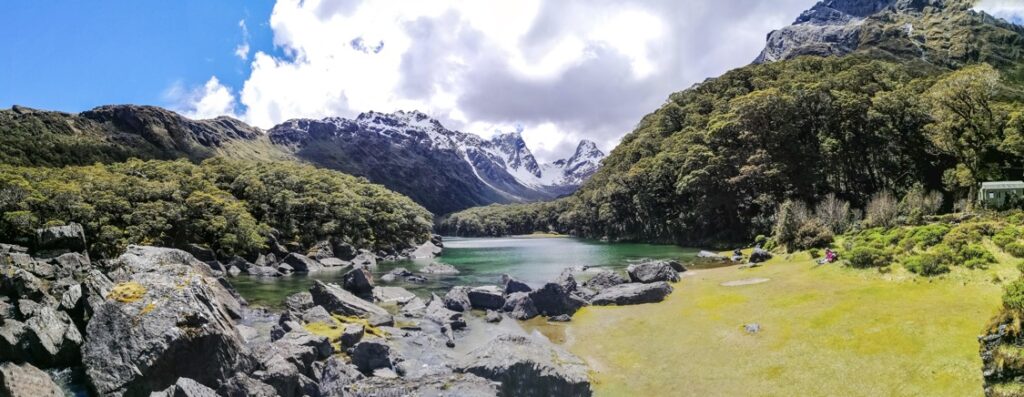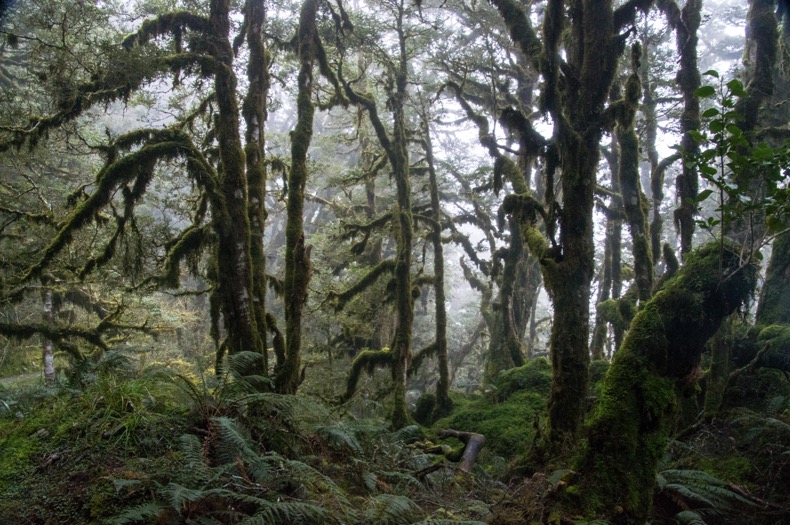
By Ananda Krishna Rajah in New Zealand
New Zealand’s south-west of South Island in Fiordland is a stunning and diverse alpine hiking environment with soaring sculptured peaks, glacial lakes, waterfalls, rivers and combined two national parks.
The 32km track can be completed in two, three or four days. It is a one-way track that start from either end – the Divide from Te Anau or the Routeburn Shelter from Glenorchy. Walking from the Divide offers an easier hike.
The starting point is the Divide, the starting point of the Routeburn. I did this hike to commemorate my sixtieth birthday.
We entered Fiordland NP and passed through Elington Valley, grouched out during the ice age, covered with golden tussock grasses, silver beech rain forest covered with lichens and carpets of lime-green moss thickets of ferns.
There are also a few Kotukutu trees, the largest fuchsia in the world, with a distinctive orange peel.
Once above the tree line, the Darran and Ailsa Mountains with the glacial carved V-shaped Hollyford Valley stretched towards the horizon. The landscape was bathed in glorious sunshine and blue sky.
At the summit, the views were stunning as an alpine lake almost enclosed with yellow moss surrounded by majestic peaks.

Walking further, the aquamarine alpine glacial Lake Marian, literally hung off the slopes of Mount Christina.
We retraced our tracks back downhill to Lake Howden Hut. It was busy with hikers packing up to leave.
The following morning, the hut was completely engulfed by heavy fog. The surrounding rainforest were just silhouettes.
The only sound I heard was my heavy breath and footsteps on the gravel track. Bird songs echoed through the misty rain forest. This is a birder’s paradise. In the background, there is a constant murmur, the sound of moving water.

Numerous streams crisscrossed the track together with waterfalls. As we got closer a loud roar resonated through the forest. A white column of water fell from a blackish cliff face. This is Earland Falls (178m).
The forest opened into a grassy area, cleared by avalanches – the Orchard. A flat area covered with grasses, ferns, flax and dotted with ribbonwood trees which resembled apple trees.
The narrow track zig-zagged along the mountain face. Clouds dissipated and exposed the Darran Mountains and the Hollyford Valley in the west. I could almost see Lake Mckerrow.
A tiny green bird, Rifleman (Titipounamu), darted around the beech canopy. The final part track ended on the flats covered with shrubs which led towards Lake Mackenzie Hut.
I was attracted towards the emerald-green Lake Mackenzie. Rough blocks of glacial rocks lay strewn on the west end of the lake. Ocean and Emily Peaks loomed above. The views were stunning.
We were fortunate with the weather. Uncertain weather was forecasted. In the hut, there was a sense of camaraderie amongst the hikers. Late at night, torrential downpour aided with gusty wind lashed with lightning and thunder. I was glad that I am tucked in my sleeping bag.
The ascending gravel track zig-zagged above the tree line around the slopes of Ocean Peak. There were great views of Lake Mackenzie.
The landscape changed from high alpine plateau of tussock grasses into a jagged rocky plateau. Unique hardy plants clung on to survive these harsh conditions.
The narrow track progressed in the shadow of Ocean Peak, parallel to the Hollyford Valley and Darran Mountains.

At Harris Saddle, the highest elevation (1255m) of the track, hale swept through as I hurried into the shelter. A few other hikers coming from the opposite direction also made a brief stop here. Moments later, sleet dropped from the dark sky.
The side trip to Conical Hill was inaccessible due to avalanches. Visibility was poor. Fortunately, the orange pole markers, provided direction. For hereon, we entered the Mount Aspiring NP and transversed Ailsa Mountains.
After a short walk over sandstone rocks, the organic black hued glacial Harris Lake appeared. Although poor weather, the expansive views were amazing. It was a surreal black and white landscape. A rare blue duck (Whio) was at home in a small lake.
On this rugged landscape of tussock flats and boulders, the head of Routeburn River cascaded down and meandered towards the rain mist covered valley below. Colored stones including greenstones “pounamu” were strewn along the track.
A loud consistent roar resonated through the valley. The torrent Routeburn Falls tumbled into a deep canyon above a cluster of corrugated iron roof tops, Routeburn Falls Hut. The rain did not relent.
Kea birds frolicked on a nearby tree. From the balcony of the hut, the lemon green flats and black slopes of the Humboldt Mountain were barely visible.
Countless waterfalls appeared on the mountain slope. This hut is in an enviable location. A helicopter ferried affluent passengers to the luxury lodge next door.
Strong winds packed with rain, thunder and lightning hit the hut at night but finally managed to get some sleep.
The next morning, heavy rain and plunging temperature are forecasted. We descended through mainly Mountain Beech forest as Fiordland lived up to its reputation – wet and unpredictable. Swollen streams crisscrossed the track. At times, the track is the stream.
The track skirted along the Routeburn River which meandered calmly through a grassy flat valley as we transversed the Humboldt Mountains.
Under one bridge, I felt its volatile power as it cascaded over buried rocks. With so much rain, there is a danger some sections may be impassable.
As elevation dropped, we entered a Red Beech Forest. Tree saplings sprouted out from rotting tree trunks. Fungus mycelium quietly eat away decaying plant materials.
With a walk across a swing bridge, I completed the hike at the Routeburn Shelter. Overall, the Routeburn Track is worthy of a hike, in any weather, in this unique UNESCO Heritage Fiordland.
Editor’s note: Ananda Krishna Rajah is a qualified horticulturist and currently a biosecurity officer with the Ministry of Primary Industries at the Auckland International Airport. Having migrated to New Zealand from Malaysia in 2001, his passion is nature and all things green.

